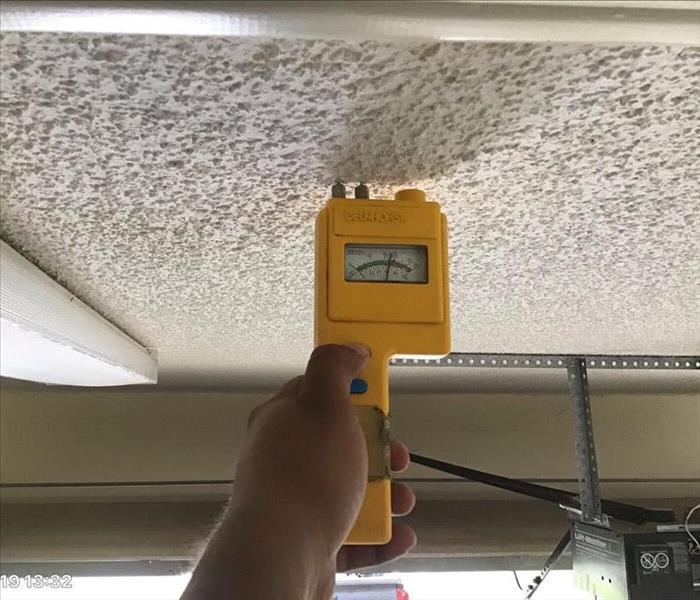Who's Responsible for Water Damage: Tenants or Landlords?
9/23/2019 (Permalink)
Repairing extensive water damage can cost a fortune. That’s why it’s critical to know when exactly the landlords or tenants are financially responsible for restoration activities. While there are state-specific differences, you’ll find all the main guidelines in this article. SERVPRO of McAllen goes over the main facts regarding water damage responsibilities in order for you to make the right decisions as soon as possible.
What are the tell-tale signs of water damage?
When water damage is mentioned, most people imagine river-like streams flooding the rooms and soaking every inch of your belongings lying on the floor. But that’s just one way to imagine water damaging the rental property.
1. Brown spots
In reality, many cases of water damage start as a subtle process. You may notice brown spots and discolored blotches appearing on the walls or ceilings. The surfactant used to bind the paint is usually brown and the intruding water separates the brown liquid from the surfaces. This is the reason behind the brown marks.
2. Different surface textures
You may also start noticing changes in the surface textures of your home. If you notice bends, bubbles, and cracks, these are all indications of an underlying disturbance that’s often caused by excess water.
3. Strange smells
Even strange smells alone may give off a warning signal that should be interpreted as a water emergency. When there’s too much moisture in the air or inside porous materials, then mold growth is a real possibility. If you notice any of these signs, act on the first signs and contact your landlord immediately. You can work together to find out the underlying causes. Not notifying your landlord after the first signs have clearly appeared could be interpreted as negligence. This situation could turn more expensive in the long run.
Landlord’s Responsibility
As a universal principle, landlords need to provide a rental space that’s safe for habitation. Lack of maintenance creates issues, making the landlord responsible for the outcome of improper care. For example, when the pipes burst because they hadn’t been changed for a long time, then the tenant isn’t clearly at fault. The landlord should have organized the plumbing works and repairs. The same goes for neglected roof problems. Upon being notified of the first issues, the landlord should have decided to get the roof fixed. That is the landlord’s responsibility.
But you should also not forget that there are situations that minimize or entirely remove the landlord’s responsibility. When the tenant has done something wrong, neglected the property, or failed to notify the landlord of the first problems, then the landlord is not responsible for paying for the repairs.
Note that not all cases are clear-cut, which means that sometimes big disagreements need a middleman to decide who’s exactly in the fault.
Grey areas of responsibility
Yes, landlords do need to keep their properties safe and fit for habitation. Once the water problem unfolds, the tenants still need to do everything they can in order to restrict the extent of the damage. For example, let’s say that your roof starts leaking during the rainstorm, and the water gushes into the house. The landlord is surely responsible for the fact that the roof wasn’t properly maintained. But your responsibility is to remove all of your personal belongings out of the water’s way.
Also, you should take every step to minimize the water from making serious damage to the property. Even taking these practical steps inside the home isn’t enough. You need to call your landlord immediately. Not having an active attitude could seriously harm your chances of getting fully reimbursed for the damage to your personal things.
Tenant responsibilities
Yes, landlords may sometimes carry out improper maintenance and repairs. But tenants might be neglectful as well. You are responsible when you go to the countryside and leave your apartment’s bathtub faucet on, flooding the whole rental along with your neighbor’s property downstairs. In this and similar cases, you have to accept the whole responsibility and the owner doesn’t need to pay a dime. Does that mean overflowing sinks and toilets are always the tenant’s fault? Not so fast. Again, if the situation is caused by bad maintenance, then the landlord is assumed to be responsible. But when the tenant has been throwing garbage into the sink or flushing things that are not toilet safe, then it’s their own fault. In many cases, the responsibility depends on the particular root causes, not the situation itself.
Balancing the risks
In fact, the answer lies in signing contracts that are detailed enough to cover the grey areas. While not every single situation can be possibly covered by the contract, there are many common scenarios that result in opposing views. Insufficiently detailed contracts lead people to consult the law and this can become quite expensive. It’s much cheaper to focus on the contract straight from the beginning, protecting yourself against unusual situations that could end up creating costly disputes in the court.
So, is the tenant or the landlord responsible for water damage? Landlords should provide a property that’s safe and fit for habitation. Reckless attitude towards any maintenance issues can result in situations where the property along with the possessions inside gets seriously damaged. In these cases, the landlord clearly needs to bear the weight of the financial responsibilities. Keep in mind that the tenant always carries responsibility when they have created an issue themselves. Also, in an emergency, they need to take necessary actions to minimize the damage and notify the landlord immediately.






 24/7 Emergency Service
24/7 Emergency Service
